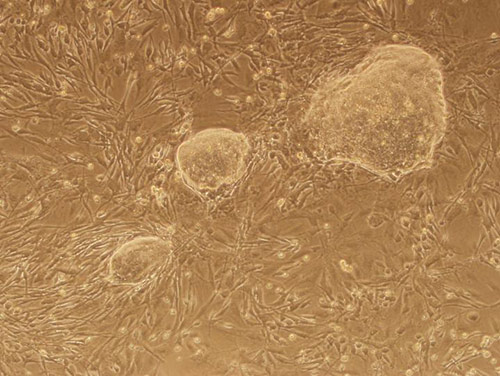![Induced pluripotent stem cell (iPS cell) colonies were generated after researchers at Harvard Stem Cell Institute suppressed the CAF1 gene. [Sihem Chaloufi]](https://genengnews.com/wp-content/uploads/2018/08/Dec15_2015_SihemChaloufi_IPSCell9321122451-1.jpg)
Induced pluripotent stem cell (iPS cell) colonies were generated after researchers at Harvard Stem Cell Institute suppressed the CAF1 gene. [Sihem Chaloufi]
Whether it is a skin cell, a heart cell, a nerve cell, or any other kind of cell, a fully differentiated adult cell stubbornly preserves its identity. The adult cell, or somatic cell, has a kind of memory, and this memory effectively blocks the procedures that scientists would use to reprogram adult cells into pluripotent stem cells.
If the adult cell’s memory could be erased, scientists based at Harvard Stem Cell Institute (HSCI) reasoned, reprogramming would become much easier, and induced pluripotent stem cells would become more readily available for a range of applications from disease modeling and drug testing to regenerative medicine. The HSCI scientists, in concert with collaborators based in Vienna, looked for the molecular factors that account for cellular memory. Several factors were found, including a newly discovered chromatin assembly factor. Suppressing this new factor dramatically enhanced reprommaing efficiency.
Details of this work appeared December 9 in the journal Nature, in an article entitled, “The histone chaperone CAF-1 safeguards somatic cell identity.” CAF-1 stands for chromatin assembly factor 1.
“To … elucidate regulatory pathways that safeguard the somatic state,” wrote the authors, “we performed two comprehensive RNA interference (RNAi) screens targeting chromatin factors during transcription-factor-mediated reprogramming of mouse fibroblasts to induced pluripotent stem cells (iPS cells).”
Of the 615 factors screened, the researchers identified four chromatin regulators, three of which had not yet been described, as potential roadblocks to reprogramming. In comparison to the three- to fourfold increase seen by suppressing previously known roadblock factors, inhibiting the newly described CAF1 made the process 50- to 200-fold more efficient. Moreover, in the absence of CAF1, reprogramming turned out to be much faster: While the process normally takes nine days, the researchers could detect the first iPS cell after four days.
“The CAF1 complex ensures that during DNA replication and cell division daughter cells keep their memory, which is encoded on the histones that the DNA is wrapped around,” said Ulrich Elling, a co-first author from Vienna’s Institute of Molecular Biotechnology. “When we block CAF-1, daughter cells fail to wrap their DNA the same way, lose this information and covert into blank sheets of paper. In this state, they respond more sensitively to signals from the outside, meaning we can manipulate them much more easily.”
By suppressing CAF-1 the researchers were also able to facilitate the conversion of one type of adult cell directly into another, skipping the intermediary step of forming iPS cells, via a process called direct reprogramming, or transdifferentiation. Thus, CAF-1 appears to act as a general guardian of cell identity whose depletion facilitates both the interconversion of one adult cell type to another as well as the conversion of specialized cells into iPS cells.
“Mechanistically, CAF-1 suppression led to a more accessible chromatin structure at enhancer elements early during reprogramming,” detailed the authors of the Nature article. “These changes were accompanied by a decrease in somatic heterochromatin domains, increased binding of Sox2 to pluripotency-specific targets and activation of associated genes.”



